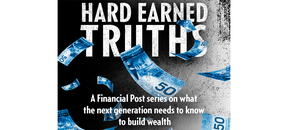Ditch these 7 investing myths to invest like a pro
April 1, 2025
Hard earned truth: Falling for myths can limit your portfolio growth and even discourage you from entering the market

Many beginner investors may be falling for these investment myths, which can lead to bad financial decisions, limit their ability to grow wealth over time and even discourage them from entering the market.
Article content
Article content
While many in younger generations such as millennials and generation Z are up against tougher financial conditions than previous generations when it comes to earning power, cost of living and employment, it’s critical to find a way to start saving, financial advisers say. One key advantage younger investors have is the power of time, and the sooner you start saving, the more you can leverage the power of compounding.
Advertisement 2
Story continues below
Article content
Here are seven myths ripe for debunking so you can make more informed decisions, reduce unnecessary risk and achieve better returns.

1. I don’t have enough money to invest
It’s difficult to break out of the cycle of living paycheque to paycheque. But even a small amount such as $50 to $100 a month goes a long way to building wealth. Just keep a few things in mind.
“The best time to start investing depends on what is going on in your life,” said Jason Heath, a fee-only, advice-only certified financial planner with Objective Financial Partners Inc. “For instance, if you have high interest-rate debt, then it’s better to pay that off than invest because your investment returns will unlikely be able to match the return of paying down high-interest consumer debt.”
Try to save 10 per cent of your pre-tax income to grow your money long-term. Don’t pass on any employer plans if offered. This includes making good use of employer registered retirement savings plan (RRSP) matching plans and employee stock purchase plans (ESSPs) at work. They allow you to buy shares of company stock monthly, often with an employer contributing an equal amount on your behalf. Even a small amount such as one per cent or two per cent of your salary can go a long way.
Article content
Advertisement 3
Story continues below
Article content
2. I can afford to wait to start investing
Worrying about saving and investing for retirement often seems a long way off and like the last thing you need to do when there are more urgent bills to pay. But that overlooks the most powerful force in investing: compound interest. This is where your money grows with interest and then that interest is reinvested, growing even more interest. Having years or decades in front of you for your investments to grow is the surest way to build wealth. For instance, just $25 invested weekly at a modest six per cent compounded annual rate of return means you will have $17,799 in your account after 10 years and a healthy $108,973 after 30 years.
3. Investing is too risky
Investing does involve risk but the level of risk varies depending on the type of investment strategy you use. “While investing does carry risks, not investing can be risky too because of the potential for savings to lose value due to inflation,” said Heath. For example, he said, while markets have gone up and down, “The S&P 500 has returned 14 per cent average annual compound rate of return over the past 10 years. The key is to understand the various types of risk, assess your personal risk tolerance, and develop a well-informed investment strategy that aligns with your short- and long-term financial goals.”
Advertisement 4
Story continues below
Article content
4. I can easily time the market and make great returns
Highly unlikely. The S&P Indices Versus Active (SPIVA) reports consistently find that the majority of active fund managers fail to outperform their benchmarks. Over a one-year period, 73 per cent of active equity fund managers underperformed their indexes. Over five years, this figure rose to 95.5 per cent. In fact, passive strategies such as simply holding a balanced exchange-traded fund (ETF) will likely give better returns over the long term. “Passive strategies get you the benchmark returns minus a cost of about 0.2 per cent,” said John De Goey, an author and portfolio manager with Designed Securities Ltd. “That’s good.”
5. Selling when the stock market drops is a good strategy
Letting fear or other emotions rule your investing decisions usually doesn’t work out well. Focusing too much on short-term losses, or gains, leads to impulsive decisions based on market fluctuations and emotion rather than long-term investment gains. For instance, if stocks are dropping, some investors panic and want to sell. “This is contrary to investors’ self-interest,” said Heath, as you may realize a loss on those stocks as they are dropping.
Advertisement 5
Story continues below
Article content
“You should be rebalancing your portfolio during these times. If you have a 60/40 portfolio of equities to fixed income, periods of steep market drops could change that to 55/45. So you would need to buy a few more equities or stocks and sell some fixed income shares to rebalance.” Alternatively, you can simply do nothing during market downturns and wait for the expected rebound. When it happens, you don’t want your investments to miss it.
6. I can expect investment gains according to what returns are
High fees erode investment gains over time, so it’s important to consider the total cost of investing, including transaction costs, portfolio management fees and other costs. These can slice one to two percentage points off your annual returns. Most times, investor expectations are just too high.
“People say 10 per cent is a reasonable average annual rate of return,” said De Goey. “No, it’s not. Guidelines for returns say you should expect TSX returns of between six per cent and seven per cent, with bonds about 3.5 per cent. That means a balanced 60/40 portfolio of equities to fixed income investments could expect a return of about 4.5 per cent to five per cent. But these returns are for the benchmarks. You can’t buy the benchmarks. So you have to buy a product with a fee and in some cases when an advisor is used, he (or she) will also charge a fee.” Meaning, a net average annual rate of return of 3.5 to four per cent is more likely and a good outcome.
Advertisement 6
Story continues below
Article content
7. I don’t have enough money saved to worry about diversifying
Diversification is just an investment strategy that limits the risks that come with investing in only one stock or one asset class. No matter the size of the portfolio, by holding diverse asset classes across different sectors and geographies investors reduce unnecessary risk and balance natural fluctuations in the market, avoiding losses.
“Sometimes a few naive investors will get lucky by buying one stock and doing exceptionally well,” said Heath. “But good diversification makes it much more likely you will do well over the long term.” It also reduces your portfolio’s volatility so you aren’t tempted to give in to emotions and change your equity holdings at the worst of times. In the end, that’s the ultimate goal of an investor in it for the long term.
Recommended from Editorial
Other hard earned truths
Bookmark our website and support our journalism: Don’t miss the business news you need to know — add financialpost.com to your bookmarks and sign up for our newsletters here.
Article content
Search
RECENT PRESS RELEASES
Related Post







